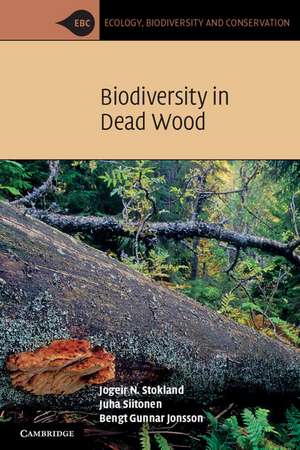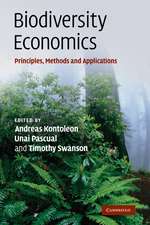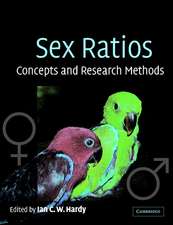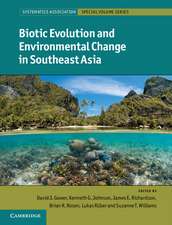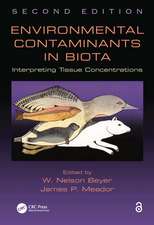Biodiversity in Dead Wood: Ecology, Biodiversity and Conservation
Autor Jogeir N. Stokland, Juha Siitonen, Bengt Gunnar Jonssonen Limba Engleză Paperback – 25 apr 2012
| Toate formatele și edițiile | Preț | Express |
|---|---|---|
| Paperback (1) | 454.97 lei 6-8 săpt. | |
| Cambridge University Press – 25 apr 2012 | 454.97 lei 6-8 săpt. | |
| Hardback (1) | 767.48 lei 6-8 săpt. | |
| Cambridge University Press – 25 apr 2012 | 767.48 lei 6-8 săpt. |
Din seria Ecology, Biodiversity and Conservation
-
 Preț: 349.59 lei
Preț: 349.59 lei -
 Preț: 276.13 lei
Preț: 276.13 lei -
 Preț: 230.82 lei
Preț: 230.82 lei -
 Preț: 307.23 lei
Preț: 307.23 lei -
 Preț: 356.75 lei
Preț: 356.75 lei -
 Preț: 274.22 lei
Preț: 274.22 lei -
 Preț: 303.89 lei
Preț: 303.89 lei -
 Preț: 351.53 lei
Preț: 351.53 lei -
 Preț: 305.80 lei
Preț: 305.80 lei -
 Preț: 320.13 lei
Preț: 320.13 lei -
 Preț: 355.36 lei
Preț: 355.36 lei -
 Preț: 278.29 lei
Preț: 278.29 lei -
 Preț: 353.48 lei
Preț: 353.48 lei -
 Preț: 328.88 lei
Preț: 328.88 lei -
 Preț: 311.14 lei
Preț: 311.14 lei -
 Preț: 387.22 lei
Preț: 387.22 lei - 11%
 Preț: 451.52 lei
Preț: 451.52 lei - 8%
 Preț: 530.70 lei
Preț: 530.70 lei -
 Preț: 314.82 lei
Preț: 314.82 lei -
 Preț: 306.08 lei
Preț: 306.08 lei -
 Preț: 471.17 lei
Preț: 471.17 lei -
 Preț: 466.38 lei
Preț: 466.38 lei -
 Preț: 402.68 lei
Preț: 402.68 lei - 14%
 Preț: 981.14 lei
Preț: 981.14 lei -
 Preț: 454.76 lei
Preț: 454.76 lei - 11%
 Preț: 565.77 lei
Preț: 565.77 lei - 14%
 Preț: 709.39 lei
Preț: 709.39 lei -
 Preț: 441.83 lei
Preț: 441.83 lei - 14%
 Preț: 929.04 lei
Preț: 929.04 lei - 11%
 Preț: 477.70 lei
Preț: 477.70 lei - 14%
 Preț: 701.48 lei
Preț: 701.48 lei - 14%
 Preț: 1013.18 lei
Preț: 1013.18 lei
Preț: 454.97 lei
Preț vechi: 511.19 lei
-11% Nou
Puncte Express: 682
Preț estimativ în valută:
87.06€ • 90.89$ • 72.05£
87.06€ • 90.89$ • 72.05£
Carte tipărită la comandă
Livrare economică 05-19 aprilie
Preluare comenzi: 021 569.72.76
Specificații
ISBN-13: 9780521717038
ISBN-10: 0521717035
Pagini: 521
Ilustrații: 92 b/w illus. 21 tables
Dimensiuni: 152 x 228 x 24 mm
Greutate: 0.84 kg
Ediția:New.
Editura: Cambridge University Press
Colecția Cambridge University Press
Seria Ecology, Biodiversity and Conservation
Locul publicării:Cambridge, United Kingdom
ISBN-10: 0521717035
Pagini: 521
Ilustrații: 92 b/w illus. 21 tables
Dimensiuni: 152 x 228 x 24 mm
Greutate: 0.84 kg
Ediția:New.
Editura: Cambridge University Press
Colecția Cambridge University Press
Seria Ecology, Biodiversity and Conservation
Locul publicării:Cambridge, United Kingdom
Cuprins
Preface; 1. Introduction; 2. Wood decomposition; 3. The saproxylic food web; 4. Other associations with dead woody material; 5. Host tree associations; 6. Mortality factors and decay succession; 7. Microhabitats; 8. Tree size; 9. The surrounding environment; 10. Evolution of saproxylic organisms; 11. Species diversity of saproxylic organisms; 12. Natural forest dynamics; 13. Dead wood and sustainable forest management; 14. Population dynamics and evolutionary strategies; 15. Threatened saproxylic species; 16. Dead wood in agricultural and urban habitats; 17. The value and future of saproxylic diversity; References; Index.
Recenzii
'The book is richly illustrated, containing dozens of photographs, plots and diagrams … The authors succeed admirably in their aim of writing a book on dead wood ecology that is 'accessible to readers without expertise in any particular discipline' … [It] is a worthwhile investment for anyone interested in dead wood ecology … The book is heartily recommended …' Nordicum-Mediterraneum: Icelandic e-Journal of Nordic and Mediterranean Studies (nome.unak.is/nm-marzo-2012/)
'… the first ever whole book to attempt an introductory synthesis of all that is known about the wildlife associated with decaying wood … I discovered [I was] finding things previously unfamiliar to me in every chapter. A great strength is the combination of mycology and entomology …' British Journal of Entomology and Natural History
'… the first ever whole book to attempt an introductory synthesis of all that is known about the wildlife associated with decaying wood … I discovered [I was] finding things previously unfamiliar to me in every chapter. A great strength is the combination of mycology and entomology …' British Journal of Entomology and Natural History
Notă biografică
Descriere
A comprehensive overview of wood-inhabiting fungi, insects and vertebrates, discussing habitat requirements along with strategies for maintaining biodiversity.
